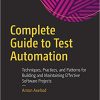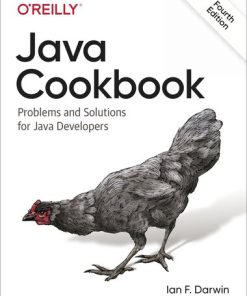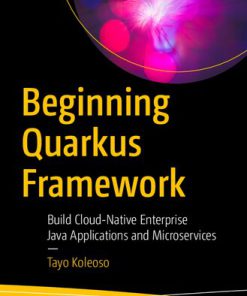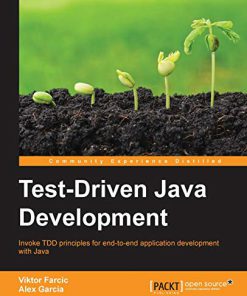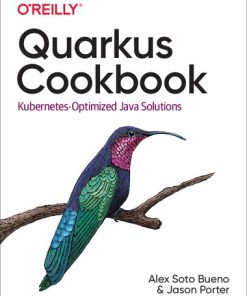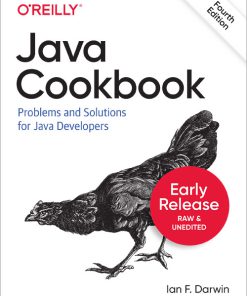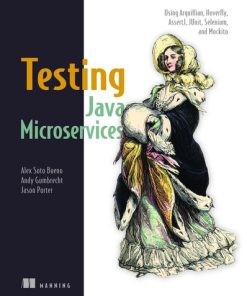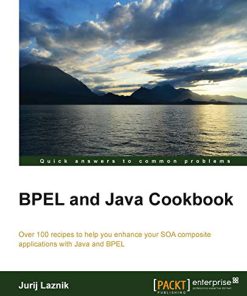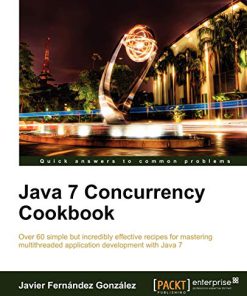Quarkus Cookbook Kubernetes Optimized Java Solutions 1st Edition by Alex Soto Bueno, Jason Porter ISBN 1492062650 978-1492062653
$50.00 Original price was: $50.00.$25.00Current price is: $25.00.
Quarkus Cookbook Kubernetes Optimized Java Solutions 1st Edition by Alex Soto Bueno, Jason Porter – Ebook PDF Instant Download/Delivery: 1492062650, 978-1492062653
Full download Quarkus Cookbook Kubernetes Optimized Java Solutions 1st Edition after payment

Product details:
ISBN 10: 1492062650
ISBN 13: 978-1492062653
Author: Alex Soto Bueno, Jason Porter
Optimized for Kubernetes, Quarkus is designed to help you create Java applications that are cloud first, container native, and serverless capable. With this cookbook, authors Alex Soto Bueno and Jason Porter from Red Hat provide detailed solutions for installing, interacting with, and using Quarkus in the development and production of microservices.
The recipes in this book show midlevel to senior developers familiar with Java enterprise application development how to get started with Quarkus quickly. You’ll become familiar with how Quarkus works within the wider Java ecosystem and discover ways to adapt this framework to your particular needs. Each stand-alone chapter features recipes written in O’Reilly’s popular problem-solution-discussion format.
Table of contents:
Foreword
Preface
Who Should Read This Book
Why We Wrote This Book
Navigating This Book
Conventions Used in This Book
Using Code Examples
O’Reilly Online Learning
How to Contact Us
Acknowledgments
1. Quarkus Overview
Developer-Friendly
Integration with Kubernetes
Memory and First Response Time
A Basic Quarkus Workflow
2. Scaffolding
2.1. Scaffolding a Quarkus Project with Maven
2.2. Scaffolding a Quarkus Project with Gradle
2.3. Scaffolding a Quarkus Project with the Quarkus Start Coding Website
2.4. Scaffolding a Quarkus Project with Visual Studio Code
2.5. Live Reloading with Dev Mode
2.6. Serving Static Resources
3. Developing RESTful Services
3.1. Creating a Simple REST API Endpoint
3.2. Extracting Request Parameters
3.3. Using Semantic HTTP Response Status Codes
3.4. Binding HTTP Methods
3.5. Enabling Cross-Origin Resource Sharing (CORS)
3.6. Using Reactive Routes
3.7. Intercepting HTTP Requests
3.8. Secure Connections with SSL
4. Configuration
4.1. Configuring the Application with Custom Properties
4.2. Accessing Configuration Properties Programmatically
4.3. Overwriting Configuration Values Externally
4.4. Configuring with Profiles
4.5. Changing Logger Configuration
4.6. Adding Application Logs
4.7. Advanced Logging
4.8. Configuring with Custom Profiles
4.9. Creating Custom Sources
4.10. Creating Custom Converters
4.11. Grouping Configuration Values
4.12. Validating Configuration Values
5. Programming Model
5.1. Marshalling/Unmarshalling JSON
5.2. Marshalling/Unmarshalling XML
5.3. Validating Input and Output Values
5.4. Creating Custom Validations
5.5. Validating Objects Programmatically
5.6. Injecting Dependencies
5.7. Creating Factories
5.8. Executing Object Life Cycle Events
5.9. Executing Application Life Cycle Events
5.10. Using a Named Qualifier
5.11. Using Custom Qualifiers
5.12. Qualifying and Configuring Annotations
5.13. Creating Interceptors
5.14. Writing Behavioral Tests
5.15. Writing Unit Tests
5.16. Creating Mock Objects
5.17. Creating Mock Objects with Mockito
5.18. Grouping Several Annotations into One with a Meta-Annotation
5.19. Executing Code Before or After a Test
5.20. Testing the Native Executable
6. Packaging Quarkus Applications
6.1. Running in Command Mode
6.2. Creating a Runnable JAR File
6.3. Über-JAR Packaging
6.4. Building a Native Executable
6.5. Building a Docker Container for JAR File
6.6. Building a Docker Container for Native File
6.7. Build and Dockerize a Native SSL Application
7. Persistence
7.1. Defining a Datasource
7.2. Using Multiple Datasources
7.3. Adding Datasource Health Check
7.4. Defining Transaction Boundaries Declaratively
7.5. Setting a Transaction Context
7.6. Programmatic Transaction Control
7.7. Setting and Modifying a Transaction Timeout
7.8. Setup with Persistence.xml
7.9. Setup Without persistence.xml
7.10. Using Entities from a Different JAR
7.11. Persisting Data with Panache
7.12. Finding All Entity Instances with Panache listAll Method
7.13. Finding Individual Entities with Panache findById Method
7.14. Finding Entities Using Panache Find and List Methods
7.15. Obtaining a Count of Entities Using the Panache count Method
7.16. Paginating Through Entity Lists Using the Panache page Method
7.17. Streaming Results via the Panache Stream Method
7.18. Testing Panache Entities
7.19. Using a Data Access Object (DAO) or Repository Pattern
7.20. Using Amazon DynamoDB
7.21. Working with MongoDB
7.22. Using Panache with MongoDB
7.23. Using Neo4j with Quarkus
7.24. Flyway at Startup
7.25. Using Flyway Programmatically
8. Fault Tolerance
8.1. Implementing Automatic Retries
8.2. Implementing Timeouts
8.3. Avoiding Overloads with the Bulkhead Pattern
8.4. Avoiding Unnecessary Calls with the Circuit Breaker Pattern
8.5. Disabling Fault Tolerance
9. Observability
9.1. Using Automatic Health Checks
9.2. Creating Custom Health Checks
9.3. Exposing Metrics
9.4. Creating Metrics
9.5. Using Distributed Tracing
9.6. Custom Distributed Tracing
10. Integrating with Kubernetes
10.1. Building and Pushing Container Images
10.2. Generating Kubernetes Resources
10.3. Generating Kubernetes Resources with Health Checks
10.4. Deploying Services on Kubernetes
10.5. Deploying Services on OpenShift
10.6. Building and Deploying a Container Image Automatically
10.7. Configuring an Application from Kubernetes
10.8. Configuring an Application from Kubernetes with Config Extension
10.9. Interacting with a Kubernetes Cluster Programmatically
10.10. Testing Kubernetes Client Interactions
10.11. Implementing a Kubernetes Operator
10.12. Deploying and Managing Serverless Workloads with Knative
11. Authentication and Authorization
Quarkus Security Basics
11.1. Authentication and Authorization with Elytron Properties File Config
11.2. Authentication and Authorization with Elytron Security JDBC Config
11.3. Authorization with MicroProfile JWT
11.4. Authorization and Authentication with OpenId Connect
11.5. Protecting Web Resources with OpenId Connect
12. Application Secrets Management
12.1. Storing Data Using Kubernetes Secrets
12.2. Store Configuration Secrets Securely with Vault
12.3. Cryptography as a Service
12.4. Generate Database Password as Secret
12.5. Authenticating Services Using Vault Kubernetes Auth
13. Quarkus REST Clients
13.1. Using the JAX-RS Web Client
13.2. Using the MicroProfile REST Client
13.3. Implementing a CRUD Client
13.4. Manipulating Headers
13.5. Using REST Client for Multipart Messages
13.6. Using REST Client to Configure SSL
14. Developing Quarkus Applications Using Spring APIs
14.1. Using Spring Dependency Injection
14.2. Using Spring Web
14.3. Using Spring Data JPA
14.4. Using Spring Security
14.5. Using Spring Boot Properties
15. Working with a Reactive Programming Model
15.1. Creating Async HTTP Endpoints
15.2. Streaming Data Asynchronously
15.3. Using Messaging to Decouple Components
15.4. Reacting to Apache Kafka Messages
15.5. Sending Messages to Apache Kafka
15.6. Marshalling POJOs into/out of Kafka
15.7. Using Kafka Streams API
15.8. Using AMQP with Quarkus
15.9. Using MQTT
15.10. Query Using Reactive SQL
15.11. Insert Using Reactive SQL Client
15.12. Using the Reactive MongoDB Client
15.13. Using the Reactive Neo4j Client
16. Additional Quarkus Features
16.1. Creating Templates with the Qute Template Engine
16.2. Rending HTML Using Qute
16.3. Changing the Location of Qute Templates
16.4. Extending Qute Data Classes
16.5. Describing Endpoints with OpenAPI
16.6. Customizing OpenAPI Spec
16.7. Sending Email Synchronously
16.8. Sending Email Reactively
16.9. Creating Scheduled Jobs
16.10. Using Application Data Caching
Minikube
Keycloak
Knative
Index
People also search for:
quarkus cookbook kubernetes optimized java solutions pdf
quarkus kubernetes operator
quarkus kubernetes-config
quarkus cookbook
quarkus on kubernetes
Tags: Alex Soto Bueno, Jason Porter, Quarkus Cookbook, Kubernetes, Optimized Java Solutions
You may also like…
Uncategorized
Computers - Networking
Java Cookbook Problems and Solutions for Java Developers final release 4th Edition Ian F. Darwin
Computers - Programming
Computers - Programming
Computers - Programming
Computers - Programming
Uncategorized
Uncategorized



